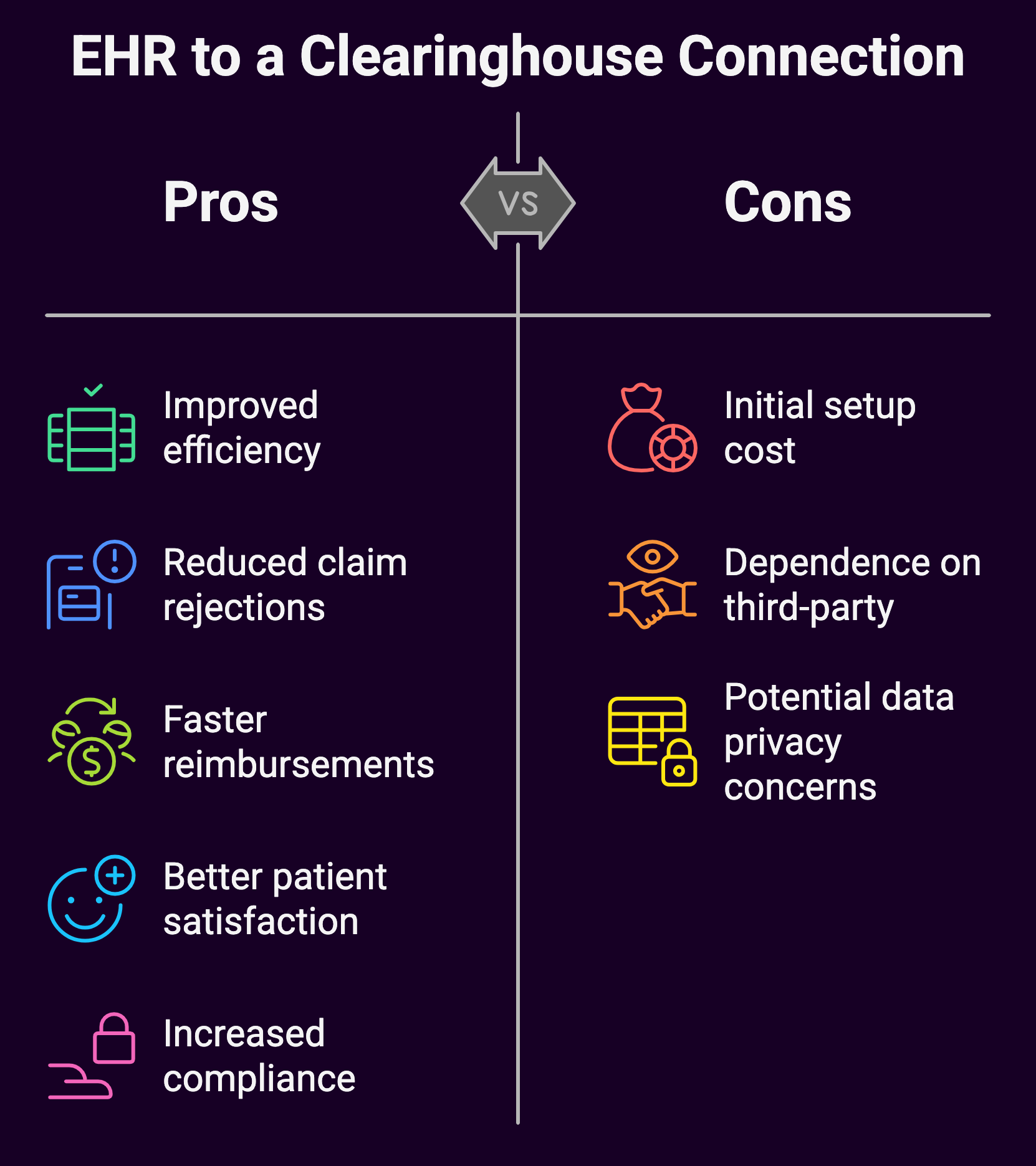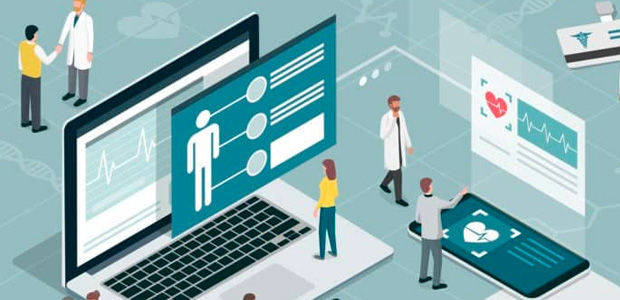Have you connected your electronic health record (EHR) system to a clearinghouse? I know what you might be thinking, “Another tech integration? Ugh, more headaches!” But bear with me, because this one’s a game-changer.
If you’re still relying on manual processes for submitting claims, verifying patient eligibility, or handling remittances, you’re basically stuck in the Stone Age of medical billing. It’s time to join the 21st century and take advantage of the efficiency and cost-savings that come with clearinghouse integration.
But before we dive into the nitty-gritty, let’s take a step back and make sure we’re all on the same page. What exactly is a clearinghouse?
What is a Clearinghouse, and Why Do You Need One?

A clearinghouse is essentially a middleman between your practice and the payers (insurance companies, government programs, etc.). It acts as a translation service, converting the data from your EHR system into a format that payers can understand and vice versa.
Now, you might be thinking, “Why can’t I just submit claims directly to the payers?” Well, that’s a surefire way to invite chaos into your life. Every payer has their own unique set of rules, requirements, and formats for claims submission. Trying to keep up with all of that would be a full-time job in itself (and most likely a mind-numbing one at that).
That’s where the clearinghouse comes in to play. It handles all the formatting and translation for you, ensuring that your claims are submitted correctly and efficiently. Plus, it can also handle other tasks like eligibility verification, remittance processing, and even some aspects of patient statement handling.
Using a clearinghouse enables you not only save yourself a ton of headaches, but you also increase your chances of getting paid faster and more accurately. It’s a win-win situation.
Benefits of Connecting Your EHR to a Clearinghouse
Now that we’ve covered the basics, let’s talk about the juicy stuff. The benefits of connecting your EHR to a clearinghouse.
Improved Efficiency and Productivity
Nobody got into the medical field because they love paperwork and administrative tasks. By connecting your EHR to a clearinghouse, you’ll be able to automate a significant portion of your billing and claims processes. No more wasting time on manual data entry, formatting, or double-checking for errors. The clearinghouse takes care of all that for you, freeing up your staff to focus on more important tasks (like, you know, taking care of patients).
Reduced Claim Rejections and Denials
There’s nothing more frustrating than having a claim rejected or denied due to a silly formatting error or missing information. Not only does it delay your reimbursement, but it also creates extra work for your staff to resubmit the claim. By using a clearinghouse, you can significantly reduce the likelihood of these kinds of errors, as the clearinghouse will catch and fix any issues before submitting the claim to the payer.
Faster Reimbursement Cycles
Time is money, and in the world of medical billing, every day counts. When you connect your EHR to a clearinghouse, your claims are processed and submitted much more quickly, which means you’ll get paid faster. No more waiting weeks or months for reimbursement. You can keep your cash flow healthy and your practice running smoothly.
Improved Patient Satisfaction
Let’s not forget about the most important people in this equation, your patients. Through streamlining your billing and claims processes, you’ll be able to provide a better overall experience for your patients. They won’t have to deal with as many billing issues or delays, which can be a major source of frustration and dissatisfaction.
Increased Compliance and Security
Compliance and security are critical in the healthcare industry, and connecting your EHR to a clearinghouse can actually help you in these areas. Clearinghouses are required to follow strict security protocols and compliance standards, ensuring that your patient data is protected and that you’re adhering to all relevant regulations.
How to Connect Your EHR to a Clearinghouse
Now that we’ve covered the “why,” let’s talk about the “how.” Connecting your EHR to a clearinghouse isn’t as complicated as it might sound, but there are a few key steps you’ll need to follow.
Choose the Right Clearinghouse
Not all clearinghouses are created equal, so it’s important to do your research and choose one that’s a good fit for your practice. Look for a clearinghouse that integrates seamlessly with your EHR system, has a solid track record of reliability and customer support, and offers the specific services and features you need (e.g., eligibility verification, remittance processing, etc.).
Set Up the Integration
Once you’ve chosen your clearinghouse, it’s time to set up the integration with your EHR system. This process will vary depending on the specific systems involved, but generally, it will involve configuring your EHR to communicate with the clearinghouse’s servers and establishing secure data connections.
If you’re not particularly tech-savvy, don’t worry. Your EHR vendor and clearinghouse should be able to provide guidance and support throughout the setup process. They may even offer on-site implementation services to make sure everything is configured correctly from the get-go.
Train Your Staff
Even with the integration in place, your staff will still need to be trained on how to use the clearinghouse effectively. This might involve learning new workflows, understanding how to interpret remittance advice (ERA) files, or troubleshooting any issues that arise.
Don’t skimp on this step! Proper training is crucial to ensuring that your clearinghouse integration is utilized to its fullest potential and that your staff is comfortable with the new processes.
Monitor and Optimize
Connecting your EHR to a clearinghouse isn’t a “set it and forget it” kind of deal. You’ll need to regularly monitor your claims and remittance data to ensure that everything is running smoothly and identify any areas for improvement.
Look for patterns in claim rejections or denials, and work with your clearinghouse to address any recurring issues. Additionally, keep an eye out for any updates or new features from your clearinghouse that could further streamline your processes or improve your reimbursement rates.
Common Concerns and How to Address Them
As with any significant change or integration, there are bound to be some concerns or potential roadblocks when it comes to connecting your EHR to a clearinghouse.
Let’s address a few of the most common ones:
Concern: It’s too expensive
While there may be some upfront costs associated with implementing a clearinghouse integration, the long-term savings and efficiency gains more than make up for it. Think about how much time and money you’re currently losing due to manual processes, claim rejections, and delayed reimbursements. A clearinghouse can help you recoup those losses and then some.
Concern: It’s too complicated
Admittedly, the idea of integrating different software systems can sound daunting, but that’s why you have experts on your side. Your EHR vendor and clearinghouse should provide comprehensive support and guidance throughout the implementation process, ensuring that everything is set up correctly and that your staff is properly trained.
Concern: Data security and compliance risks
This is a valid concern, as healthcare data is highly sensitive and subject to strict regulations. However, reputable clearinghouses are required to follow stringent security protocols and compliance standards, often exceeding the requirements of individual practices. By partnering with a reliable clearinghouse, you can actually improve your data security and compliance posture.
Concern: Disruption to existing workflows
Change can be unsettling, especially when it comes to processes that your staff has become accustomed to. However, with proper training and a well-planned implementation strategy, any disruptions can be minimized. Plus, the long-term efficiency gains and improved workflows will more than make up for any short-term growing pains.
Real-World Examples and Success Stories
Still not convinced?
Let’s take a look at some real-world examples of how connecting an EHR to a clearinghouse has benefited medical practices:
Example 1: Improved Reimbursement Rates
A small family practice in California was struggling with a high rate of claim rejections and denials, leading to significant delays in reimbursement and cash flow issues. After connecting their EHR to a clearinghouse, they saw an immediate improvement in their clean claim rate (claims accepted on the first submission). Within the first year of using the clearinghouse, their reimbursement rates increased by over 20%, allowing them to get paid faster and maintain a healthier cash flow.
Example 2: Streamlined Eligibility Verification
A multi-specialty clinic in Texas was spending countless hours each week verifying patient eligibility and benefits manually. This not only tied up valuable staff resources but also led to frequent errors and delays in scheduling appointments. By integrating their EHR with a clearinghouse that offered real-time eligibility verification, they were able to automate this process, freeing up staff time and ensuring that patients were accurately qualified before their appointments.
Example 3: Improved Patient Satisfaction
A large healthcare system in Florida was receiving a high volume of patient complaints related to billing issues, such as incorrect statements, delays in processing payments, and general confusion about the billing process. After connecting their EHR to a clearinghouse that handled remittance processing and patient statement generation, they saw a significant reduction in billing-related complaints. Patients appreciated the more streamlined and accurate billing experience, leading to improved overall satisfaction scores.
These are just a few examples, but the stories of improved efficiency, increased revenue, and better patient experiences are common among practices that have taken the leap and connected their EHR to a clearinghouse.
The Future of Clearinghouse Integrations
As technology continues to grow, so too will the capabilities and functionalities of clearinghouses and their integrations with EHR systems.
Here are a few trends and developments to keep an eye on:
Artificial Intelligence and Machine Learning
Clearinghouses are already beginning to incorporate AI and machine learning algorithms to further automate and optimize claims processing, eligibility verification, and other tasks. These technologies can identify patterns and make intelligent predictions, potentially leading to even higher clean claim rates and faster reimbursements.
Blockchain and Distributed Ledger Technologies
The healthcare industry is exploring the use of blockchain and distributed ledger technologies to improve data security, transparency, and interoperability. Clearinghouses may eventually leverage these technologies to facilitate secure, tamper-proof data exchanges between providers, payers, and other stakeholders.
Interoperability and Data Exchange Standards
As the push for greater interoperability in healthcare continues, clearinghouses will play a crucial role in facilitating data exchange between different systems and stakeholders. Emerging standards like HL7 FHIR (Fast Healthcare Interoperability Resources) will likely become more prevalent, enabling seamless data sharing and communication.
Expanded Service Offerings
While clearinghouses have traditionally focused on claims processing and related tasks, some are already expanding their service offerings to include areas like revenue cycle management, analytics, and practice management solutions. This trend towards more comprehensive, integrated solutions could further streamline and optimize medical billing and practice operations.
The bottom line is that the clearinghouse landscape is continually evolving, and those practices that embrace these technologies and integrations will be well-positioned to thrive in the ever-changing healthcare landscape.
Pros & Cons in Connecting an EHR to Clearinghouse

Summary: Making the EHR to Clearinghouse Connection
The aforementioned content shows you why and how to connect your EHR to a clearinghouse and the many benefits it can bring to your medical practice. From improved efficiency and faster reimbursements to better patient satisfaction and increased compliance, the advantages are numerous and hard to ignore.
Of course, no integration or technology implementation is without its challenges, but with the right partner, proper planning, and a willingness to embrace change, those hurdles can be easily overcome.
What are you waiting for? It’s time to ditch those outdated, manual processes and join the 21st century of medical billing. Now, you know how to connect your EHR to a clearinghouse. Watch as your practice becomes more streamlined, more profitable, and better equipped to serve your patients.
If you’re looking for help setting up the connection, we can help you through our HL7 integration option.

